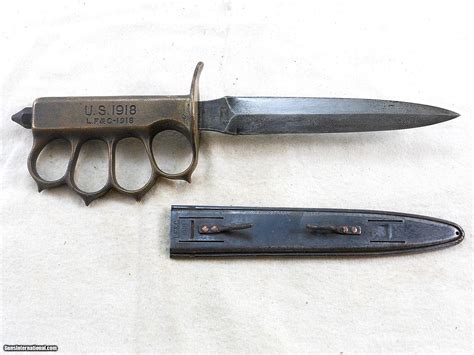The World War One trench knife is an iconic and feared close combat weapon that was used during one of the most brutal conflicts in human history. Developed as a response to the stalemate of trench warfare, where traditional rifles and bayonets were often ineffective, the trench knife was designed for hand-to-hand combat in the tight and claustrophobic spaces of the trenches. The use of trench knives became a hallmark of the brutal and intimate nature of World War One combat, where soldiers on both sides of the conflict relied on these deadly tools to survive.
The concept of a dedicated close combat knife was not new even during World War One. However, the trench knife, as it came to be known, was specifically designed with the trench warfare environment in mind. It typically featured a short, sturdy blade with a sharp point, designed for stabbing rather than slashing, and a handle that could be securely gripped even in muddy or bloody conditions. Some trench knives were also designed with additional features such as a knuckle guard or a spike on the end of the handle, which could be used to punch or bludgeon an opponent.
Key Points
- The World War One trench knife was designed for close combat in the trenches, emphasizing stabbing over slashing.
- These knives often featured a short, sturdy blade and a secure grip to facilitate use in tight spaces.
- Trench knives were used by soldiers on both sides of the conflict, becoming a symbol of the brutal nature of trench warfare.
- The development of trench knives reflected the adaptations soldiers and militaries made to the unique challenges of World War One.
- Despite their fearsome reputation, trench knives were not as widely used as other weapons, due to the general preference for firearms and the fact that close combat was relatively rare compared to artillery and rifle fire.
Evolution and Use of Trench Knives

The evolution of the trench knife during World War One was rapid and often makeshift. Early in the war, soldiers on both sides used whatever was available, including hunting knives, bayonets, and even improvised knives made from scrap metal. As the war dragged on and the nature of trench warfare became clearer, specific designs for trench knives began to emerge. These were often produced in large quantities and issued to soldiers, especially those in elite or special units like the French Chasseurs or the German Stoßtruppen.
The use of trench knives in combat was often romanticized in the press and in popular culture, with stories of daring raids and heroic hand-to-hand combat. In reality, the use of trench knives was typically limited to specific situations, such as during raids on enemy trenches or in the chaos of a breakdown in the front lines. Despite this, the trench knife became an enduring symbol of the World War One soldier, representing the brutal, personal nature of combat in the trenches.
Design and Manufacturing Variations
Trench knives showed a wide range of design and manufacturing variations, reflecting the improvisational nature of their development and the different priorities of various military forces. Some knives, like the American M1918, featured a simple, straightforward design with a short blade and a basic handle. Others, such as the German Nahkampfmesser, included more complex features like a double-edged blade or a metal scabbard. The materials used also varied, from high-carbon steel for the blade to wood, metal, or even rubber for the handles.
| Country | Trench Knife Model | Notable Features |
|---|---|---|
| United States | M1918 | Short blade, basic handle, issued in large quantities |
| Germany | Nahkampfmesser | Double-edged blade, metal scabbard, issued to special units |
| France | Lebel | Longer blade compared to others, often used by French elite units |

Legacy of the Trench Knife

The trench knife’s legacy extends beyond its use in World War One. It influenced the development of combat knives in subsequent conflicts, including World War Two, where similar designs were used by soldiers in various theatres. The psychological impact of the trench knife, as a symbol of the brutal and personal nature of close combat, has also endured, appearing in literature, film, and popular culture as a representation of the horrors of war.
Today, collectors and historians continue to study and preserve trench knives as artifacts of World War One, offering insights into the lives of soldiers and the nature of combat during that period. The trench knife serves as a tangible connection to the past, a reminder of the innovations and adaptations that occurred under the pressures of war, and a symbol of the enduring impact of World War One on modern society.
What was the primary purpose of the trench knife in World War One?
+The primary purpose of the trench knife was for close combat in the trenches, where traditional firearms were less effective due to the tight spaces and the need for silent, surprise attacks.
Which countries developed and used trench knives during World War One?
+Several countries, including the United States, Germany, France, and Britain, developed and used trench knives during World War One. Each country had its own designs and priorities, reflecting their military strategies and technological capabilities.
What impact did the trench knife have on the development of future combat knives?
+The trench knife significantly influenced the development of combat knives in subsequent conflicts. Its design principles, such as a short, sturdy blade and a secure grip, were incorporated into later combat knife designs, reflecting the lessons learned from World War One about the importance of close combat capabilities.



